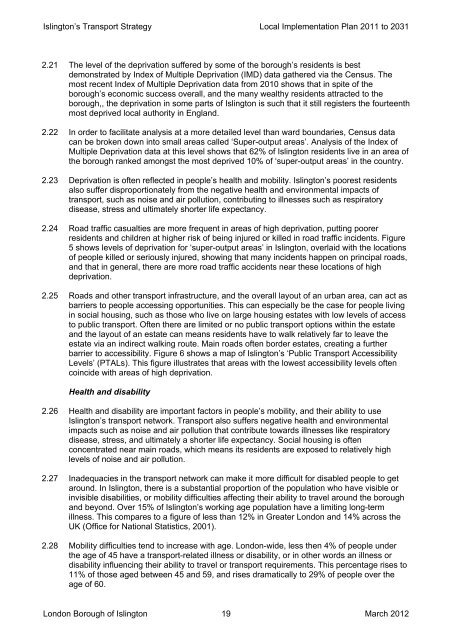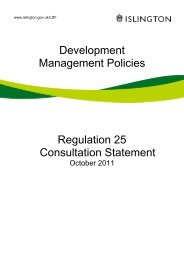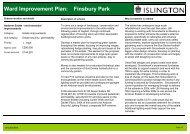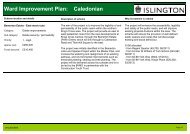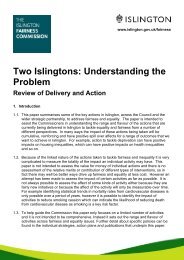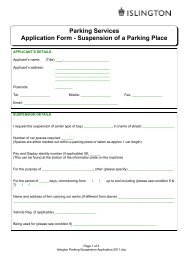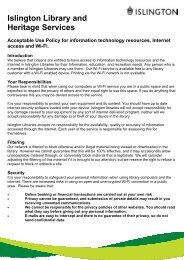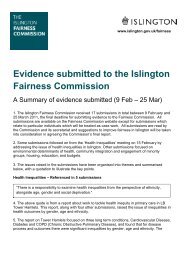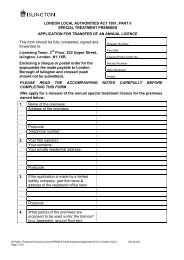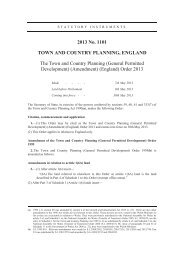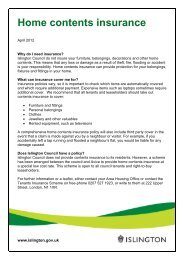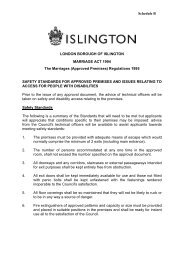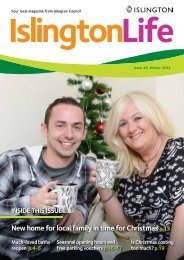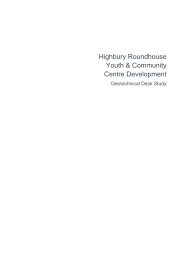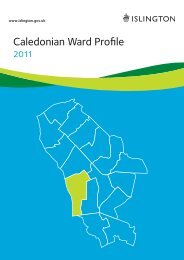Islington's Transport Strategy and Local ... - Islington Council
Islington's Transport Strategy and Local ... - Islington Council
Islington's Transport Strategy and Local ... - Islington Council
You also want an ePaper? Increase the reach of your titles
YUMPU automatically turns print PDFs into web optimized ePapers that Google loves.
<strong>Islington</strong>’s <strong>Transport</strong> <strong>Strategy</strong> <strong>Local</strong> Implementation Plan 2011 to 2031<br />
2.21 The level of the deprivation suffered by some of the borough’s residents is best<br />
demonstrated by Index of Multiple Deprivation (IMD) data gathered via the Census. The<br />
most recent Index of Multiple Deprivation data from 2010 shows that in spite of the<br />
borough’s economic success overall, <strong>and</strong> the many wealthy residents attracted to the<br />
borough,, the deprivation in some parts of <strong>Islington</strong> is such that it still registers the fourteenth<br />
most deprived local authority in Engl<strong>and</strong>.<br />
2.22 In order to facilitate analysis at a more detailed level than ward boundaries, Census data<br />
can be broken down into small areas called ‘Super-output areas’. Analysis of the Index of<br />
Multiple Deprivation data at this level shows that 62% of <strong>Islington</strong> residents live in an area of<br />
the borough ranked amongst the most deprived 10% of ‘super-output areas’ in the country.<br />
2.23 Deprivation is often reflected in people’s health <strong>and</strong> mobility. <strong>Islington</strong>’s poorest residents<br />
also suffer disproportionately from the negative health <strong>and</strong> environmental impacts of<br />
transport, such as noise <strong>and</strong> air pollution, contributing to illnesses such as respiratory<br />
disease, stress <strong>and</strong> ultimately shorter life expectancy.<br />
2.24 Road traffic casualties are more frequent in areas of high deprivation, putting poorer<br />
residents <strong>and</strong> children at higher risk of being injured or killed in road traffic incidents. Figure<br />
5 shows levels of deprivation for ‘super-output areas’ in <strong>Islington</strong>, overlaid with the locations<br />
of people killed or seriously injured, showing that many incidents happen on principal roads,<br />
<strong>and</strong> that in general, there are more road traffic accidents near these locations of high<br />
deprivation.<br />
2.25 Roads <strong>and</strong> other transport infrastructure, <strong>and</strong> the overall layout of an urban area, can act as<br />
barriers to people accessing opportunities. This can especially be the case for people living<br />
in social housing, such as those who live on large housing estates with low levels of access<br />
to public transport. Often there are limited or no public transport options within the estate<br />
<strong>and</strong> the layout of an estate can means residents have to walk relatively far to leave the<br />
estate via an indirect walking route. Main roads often border estates, creating a further<br />
barrier to accessibility. Figure 6 shows a map of <strong>Islington</strong>’s ‘Public <strong>Transport</strong> Accessibility<br />
Levels’ (PTALs). This figure illustrates that areas with the lowest accessibility levels often<br />
coincide with areas of high deprivation.<br />
Health <strong>and</strong> disability<br />
2.26 Health <strong>and</strong> disability are important factors in people’s mobility, <strong>and</strong> their ability to use<br />
<strong>Islington</strong>’s transport network. <strong>Transport</strong> also suffers negative health <strong>and</strong> environmental<br />
impacts such as noise <strong>and</strong> air pollution that contribute towards illnesses like respiratory<br />
disease, stress, <strong>and</strong> ultimately a shorter life expectancy. Social housing is often<br />
concentrated near main roads, which means its residents are exposed to relatively high<br />
levels of noise <strong>and</strong> air pollution.<br />
2.27 Inadequacies in the transport network can make it more difficult for disabled people to get<br />
around. In <strong>Islington</strong>, there is a substantial proportion of the population who have visible or<br />
invisible disabilities, or mobility difficulties affecting their ability to travel around the borough<br />
<strong>and</strong> beyond. Over 15% of <strong>Islington</strong>’s working age population have a limiting long-term<br />
illness. This compares to a figure of less than 12% in Greater London <strong>and</strong> 14% across the<br />
UK (Office for National Statistics, 2001).<br />
2.28 Mobility difficulties tend to increase with age. London-wide, less then 4% of people under<br />
the age of 45 have a transport-related illness or disability, or in other words an illness or<br />
disability influencing their ability to travel or transport requirements. This percentage rises to<br />
11% of those aged between 45 <strong>and</strong> 59, <strong>and</strong> rises dramatically to 29% of people over the<br />
age of 60.<br />
London Borough of <strong>Islington</strong> 19 March 2012


